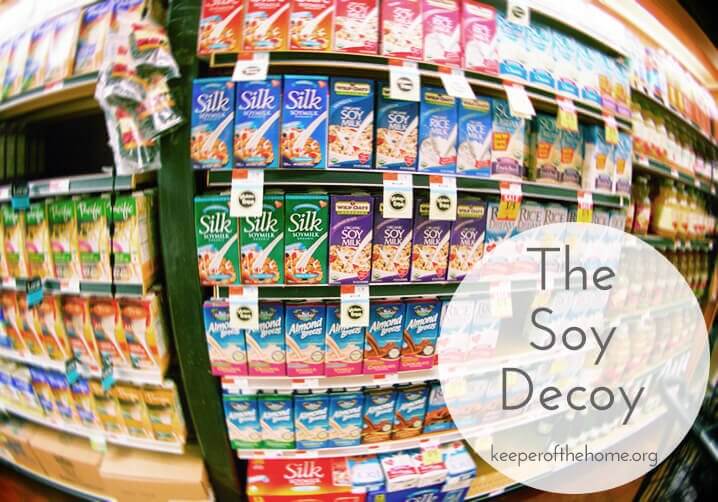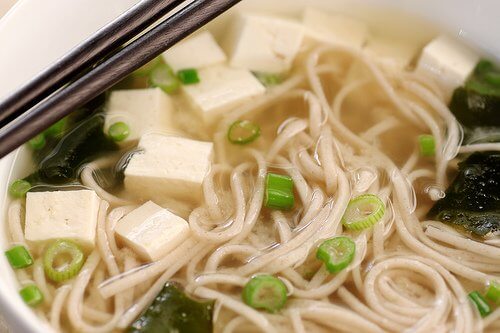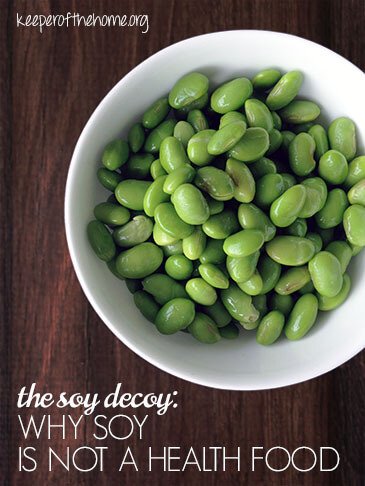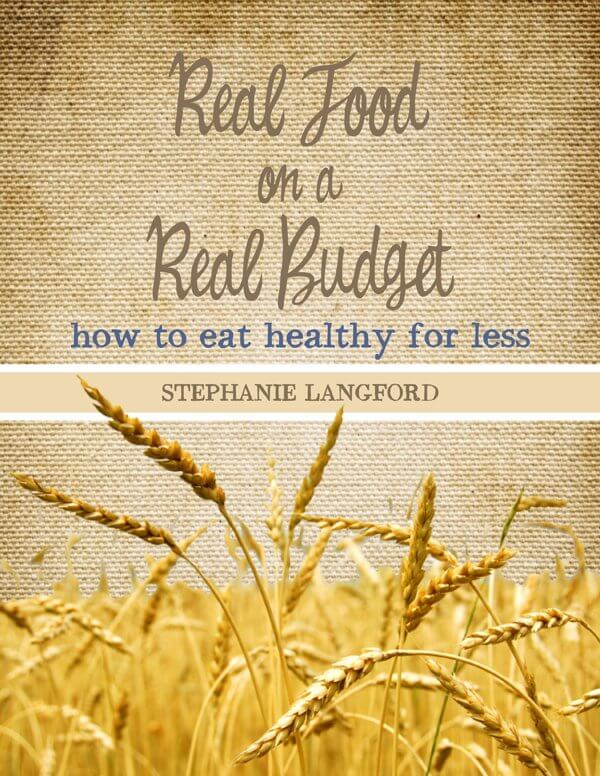The Soy Decoy: Why Soy is Not a Health Food

This post was originally published in June of 2010, but the topic is still pertinent today! Soy is one of the most commonly mistaken modern “health foods”, and unfortunately, can be found in just about everything in the form of soy lecithin. This article covers why this plant is not at all what we should be putting in our bodies and explains why soy is not a health food!
Guest Post by Katie Fox
I know it goes against everything we hear these days about healthy eating, but I’m here today to tell you that I don’t eat soy products, and I don’t think you should eat soy products, either.
There. I came right out and said it. Might as well get the controversy right out in the open from the start, right? (wink)
Honestly, I’m not looking for a fight. In my real off-line life, I almost never talk about dietary choices with people unless they flat-out ask me my opinion. Diet is a really personal thing, and people often feel defensive if their choices are questioned. But the soy issue really concerns me, so I decided to take this opportunity while guest-posting here at Keeper of the Home to talk about the side of soy we don’t usually hear about.
You’re about to read a lot of big, scientific-sounding words, but don’t let it phase you. I’ve tried to put everything into plain-Jane language, for me as much as for anyone else – I’m definitely no scientist! But I believe there are at least three good reasons for avoiding soy, and it’s important to understand them. Here they are.
1. Soy Disrupts Our Sex Hormones
Soy is known as a phyotestrogen. This means that it contains natural compounds that mimic estrogen in our bodies. This sounds like good news for some people, such as post-menopausal women. But what are the effects of phytoestrogens on babies, little boys and little girls, young women and young men?
For babies on soy formula, a 1994 study shows that they are consuming the hormonal equivalent of up to 10 contraceptive pills a day. Little systems can’t handle that overload; it puts children at risk for everything from early-onset puberty to permanent endocrine damage. This might surprise you: the governments of Israel, Switzerland, the UK, and New Zealand have all issued statements against the use of soy formula for babies.
Little boys who consume soy may have higher risks of testicular cancer, and little girls may face higher risks of breast and ovarian cancers, due to longer exposure to sex hormones. There is also a possible link between soy and lower sperm counts in young men.
Just 100 grams of soy contains the hormonal equivalent of one contraceptive pill. Considering all the hormonal diseases that are running rampant today in the West (including infertility), it seems wise to check our consumption of soy.
2. Soy Disrupts Our Thyroid
The thyroid is part of the endocrine system, just as the sex hormones are, so these two issues are intimately related. The phytoestrogens in soy also act upon the thyroid to have a goitrogenic effect, which means they depress thyroid hormone production, slow down thyroid metabolism, and potentially cause an increase in the size of the thyroid (known as a goiter, hence the term goitrogenic). All of that adds up to one thing: hypothyroidism.
I have suffered from hypothyroidism since 2001, possibly earlier. There are many symptoms of this disease, and it is often overlooked or misdiagnosed as depression (which at first happened to me). In fact, some experts estimate that there are as many as nine million undiagnosed cases of hypothyroidism in the United States alone. If you have any hypothyroid symptoms, try to eliminate soy from your diet right away.
3. Soy Contains Anti-Nutrients
Anti-nutrients are chemicals and compounds that prevent nutrients from being properly used by the body. Here are two examples of anti-nutrients found in soy:
Protease Inhibitors
Soy contains protease inhibitors, which frustrate the body’s digestion of protein. Studies show that this could cause the pancreas to be over-worked in the digestion process, and eventually lead to pancreatic dysfunction. Protease inhibitors are found in especially high amounts in raw soy – one reason raw soybeans are considered toxic. Heating and processing the soy lessens the amount of protease inhibitors considerably, but it is never completely eliminated.
Phytic Acid (or Phytates)
Soy (and many other grains, as well) contains phytic acid, which acts like a magnet for many important minerals, such as calcium, magnesium, zinc, and iron, therefore preventing their absorption into the body. Though phytic acid can also help with ridding the body of unnecessary and/or unwanted heavy metals such as lead and mercury, this cleansing effect is bad news for those who rely heavily on soy for mineral content in their diet, such as those in developing nations.

Image by little blue hen
What About Soy in Asian Cultures?
Many people are understandably surprised when they discover the negative effects of soy, and often point out that Asian cultures have eaten soy for thousands of years, with seemingly great health benefits. There are two important factors to consider here.
1. Asian cultures have historically eaten soy primarily in its fermented forms: miso, tempeh, soy sauce, and tamari are all fermented soy products. The fermenting process significantly lessens the protease inhibitors and phytates in soy, almost to the point of elimination. Tofu is the only non-fermented form of soy that has been historically common in Asian cultures.
2. Traditionally, Asian cultures have eaten these soy products in small amounts, more as sauces and condiments than main dishes. A typical starter of soup with three cubes of tofu is very different from a tofu-based entree where tofu is acting as a meat substitute. The average Asian diet in China, Indonesia, Korea, Japan, and Taiwan includes between nine and 36 grams of soy per day. Compare that to a cup of tofu (252 grams) or soy milk (240 grams).
In our home, we do eat small amounts of fermented soy, such as tamari and miso, very occasionally. But we completely avoid the newer forms of highly processed soy products such as soy milk, soy protein isolate (common in protein and energy bars), soy protein powder, and soy cheese. These are totally outside the historical understanding and consumption of soy in Asian cultures. In addition, some of them, such as soy protein isolate, contain much higher concentrations of phytoestrogens than less-processed, more traditional soy forms.

A Few Last Things To Consider
The soy industry is just that – an industry, with the goal of making money. They are desperate to convince us that soy is a miracle health food, and they have invested millions of dollars in marketing to do just that – quite successfully, I would add. For every risk I mentioned above, there is another study that contradicts that risk and wants to call me crazy.
Soy is not without its benefits, I admit. But I encourage you all to check out the facts for yourself. There is just too much evidence of unnecessary risk for me to consider soy products to be an acceptable food source in our home. What about you?
Learn more about soy from these sources, which I used in writing this article:
Nourishing Traditions, by Sally Fallon
The Whole Soy Story, by Kaayla T. Daniel, PhD
Whole Soy Story.com
Soy Online Service.co.nz
Soy Alert: Health Food or Danger?
Natural Health News: Be Aware of Soy Risks
Do Soy Foods Negatively Affect Your Thyroid?
Wikipedia: Soybean
Have you ever heard about these risks associated with soy? What do you think?
**A note from Stephanie: For those curious about my stance on soy, I think that Katie has summed it up very well. I could have written this post myself, and would have said very similar things. Our family also avoids all processed, more modern forms of soy and only consumes naturally fermented and organic soy in very minimal amounts.**
 Katie Fox loves to learn about natural living, and believes that caring for the earth and caring for yourself don’t have to be mutually exclusive. She loves to help other people understand how they can both contribute to and benefit from a switch to a more natural and organic lifestyle. She is a stay-at-home mom and a native Texas girl, happily married to her best friend. She is the editor of the popular blog, Simple Organic.
Katie Fox loves to learn about natural living, and believes that caring for the earth and caring for yourself don’t have to be mutually exclusive. She loves to help other people understand how they can both contribute to and benefit from a switch to a more natural and organic lifestyle. She is a stay-at-home mom and a native Texas girl, happily married to her best friend. She is the editor of the popular blog, Simple Organic.
Top Image by Sarah Gilbert




Good article. Since over 90% of soy produced in the U.S. Is genetically modified, there are numerous reasons that people should stay away from soy besides those issues you mentioned. It’s truly surprising (and criminal, in my opinion) how many doctors don’t tell people being treated for thyroid issues to stay away from soy.
I recommend that everyone read the book “The Whole Soy Story” before using another bit of it.
Very very good post and straight to the point. Well written. The whole thing about soy formula as a healthy alternative drives me nuts. When my daughter was diagnosed with severe cow’s milk allergy at 6 months (that’s not even 4 years ago) you wouldn’t believe the number of people, especially doctors and high profile nutritionnists who advised me to put her on soy formula, “nothing’s been proven against it in serious recent research” they said. So glad I didn’t do it and breastfed until she was 3 instead.
The other issue not mentioned is if you are not eating soy grown organically, it is genetically modified or GMO…another huge health controversy.
I recall growing up in the 80s how soy was touted as the next best thing since sliced bread. Soy milk was a staple at our house, although thankfully I didn’t drink it plain. My mom made hot cereal with it, and that is how I mainly consumed it.
At least then it wasn’t GMO…. but now it is hidden in everything!
I do like Miso…. so I do eat that sometimes (I live in Panama two blocks from this beach right here:
http://trypanama.com/listings/unique-costa-grande-condo-for-sale-in-gorgona/ (that is the only picture I could find that is close to where I live)
The folks here eat a LOT of fish, but they do not eat much soy. However, in the tiny health food section of the store here they do a lot of sugar free “artificially sweetened” processed foods and soy milk. I think that is a bit backward. They have Splenda everywhere (it is crazy I think, they use it more than they use sugar and the cool thing is you can get sucanat and raspadura sugar here everywhere you go, in every supermarket). They even have sugar cane in all its wonderful glory.
While Panama has its beautiful tropics and so many benefits, I still miss home, and would love to go back sometime. I don’t want to stay here forever.
I discovered this the hard way. After consuming lots of “healthy” nonGMO soy smoothies I found I had a very large uterine fibroid. After doing research I discovered the same things you wrote about….maybe 8 years ago. Of course the doctors wanted to remove it…but if I keep my diet clean…and don’t eat estrogen stimulating foods and stay away from chemicals in my house hold….I am able to keep it small. It’s supposed to disappear after menopause but, our world is filled with hormones and so that may not be the case. I can live with it now as it is no longer noticeable. I tell my friends to stay away from soy, but it’s a hard sell. Especially as some companies known for their ‘safe and healthy’ lifestyle products and supplements have organic versions and supposedly process it differently. I only know that I cross my fingers and flee from soy.
Thanks for the informative article. I hope many take note and change their habits for health.
I first heard about the dangers of soy when I read the books What your Dr. May Not Tell You about Menopause and What Your Dr. May Not Tell You About Premenopause. Another option you may want to research in regards to the fibroid is the book A World Without Cancer. It is all about vitamin B17 (Amygdalin) found in foods, but highest in Apricot pits. My mother-in-law went through cancer this last year, and after all my reading I consume about 10 apricot pits a day to help keep cancer at bay. B17 is controversial according to the FDA, and it is exactly for that reason that it sparked my interest. Just reading reviews on amazon alone is fascinating.
I had heard for a while that soy was a no-no but wasn’t too sure why. Thank you for this informative post. I don’t like how sneaky it is with the soy lecithin (which I had heard about how that was in everything). We don’t have any soy products in our home that are full soy – I’ll have to double check other things!
I’m glad to see more and more information out there about the detrimental effects and pervasiveness of soy in its processed, unnatural form. African-American women have significantly higher rates of fibroids, and the misinformation regarding soy as a health food might encourage these women who wish to have a more healthy diet to replace animal proteins with soy.
What about non-GMO edamame?
I’m shocked and disappointed all at the same time. We have never eaten any of the newer processed foods you mentioned but we do occasionally eat tofu. Bummer. We all love it here at home. But it seems on occassion it is ok?
Yeah, I would say on occasion or in small amounts, it’s ok. If you’re avoiding the more processed versions of it, then that’s the biggest thing. I would try to only buy organic tofu, though, at the very least.
I understand this article was written in 2010 but are there any links available to current research on soy formula and the risk to children? Many of the links in the Wikipedia article point to studies that disprove negative effects on adults. I found one current article as it relates to young girls and soy formula but the results are overwhelmingly inconclusive. http://www.ncbi.nlm.nih.gov/pubmed/22324503
Eek, I mean actual studies, not articles.
Here is a list of several studies regarding soy and children. Several of them have link to the free full article.
http://www.ncbi.nlm.nih.gov/pubmed?linkname=pubmed_pubmed_reviews&from_uid=23964404
I would pay close attention to the source of funding, and any conflicts of interest for the free publications you can access. These are usually listed at the end of the publication.
Just a note about soy sauce – there is an alternative out there that tastes similar and is GOOD! Coconut aminos. You can find them in the soy sauce section at Whole Foods and probably at Amazon.com. We’ve eliminated soy, too.
what do you think about making soy milk from your own soy beans? Do you feel that is similar to the soy milk that you purchase at the stores? Or is that a little better?
My 3 year old son was recently taken off dairy. He doesn’t like almond milk (will not drink it!) so what am I supposed to.do for him? Any suggestions would be appreciated. Thank you!
Milk, per se, is not needed in an adult diet. Do you need a substitute for school? You could try giving him other foods with nutrients that can be found in milk (broth is excellent as are greens of all types).
My daughter is allergic to dairy also and can’t drink any of the other ones, soy, almond, so I get rice milk, she likes the taste and it is healthy.
Thank you, thank you, thank you for this post! I can’t tell you how often I get the deer-in-the-headlight look when I’m asked why I read labels looking for soy ingredients, or why I buy eggs from chickens fed soy-free feed. I had heard several years ago about soy not being good for you, but it wasn’t until I read Dr. Kaayla T. Daniels’ book “The Whole Soy Story” that I fully realized what soy can do to our bodies. Now factor in that most of it is genetically modified. I am especially vigilant about soy where my daughter is concerned. We’ve never eaten a diet big in processed foods, but before we started to be careful and eliminating as much soy as possible from our diet, she started exhibiting noticeable hormonal activity — breast buds at barely 7 years old. There is no genetic predisposition to this on either side of our family. Now that we’ve eliminated as much soy as we can, we’ve noticed over the past year that her buds have diminished in size. Could be coincidence, but I don’t believe that to be the case. Hormonal disruption is only one side effect from soy consumption. Most libraries have Dr. Daniels’ book, and I would encourage people to check it out and read it. It is a HUGE eye-opener.
Isn’t it funny how the soy-food industry has taken the few tiny potential benefits of soy and totally blown them up in an attempt to mask the real disruptive harm that soy can produce in the human body in larger quantities. It’s very easy to get hooked on their hype, because they make soy sound like the answer to so many dietary problems. When in reality, they’re causing still more complications to our over-burdened bodies.
It is so helpful to see these facts about soy spelled out so simply. Thank you for sorting through all of the confusing information out there!
You are absolutely right! These are all important facts that are very relevant today.
It reminds me of what Sally Fallon and Mary Enig (both PhDs) said at the International Soy Symposium: “Far from being the perfect food, modern soy products contain antinutrients and toxins, and they interfere with the absorption of vitamins and minerals.” And that was in 2000! I wonder why the hype hasn’t died off in the face of the evidence!
what about edamame?